Introduction: Vietnam’s Booming Crypto Market Demands Trust
Vietnam’s cryptocurrency adoption has surged to 32% of its 100M population (Vietnam Blockchain Association, 2025), with young investors (18-35) comprising 68% of active traders. As the State Bank of Vietnam (SBV) tightens regulations—most recently mandating ISO 27001 certification for exchanges by Q4 2025—local investors prioritize tiêu chuẩn an ninh blockchain (blockchain security standards) and ví điện tử an toàn (secure wallets). Against this backdrop, platforms like HIBT are redefining crypto portfolio growth by merging cutting-edge security with localized solutions. This report unpacks how HIBT empowers Vietnamese traders to scale assets while mitigating risks.
1. Vietnam’s Crypto Landscape: Opportunities and Security Imperatives
1.1 Market Size and Investor Demographics
Vietnam ranks 3rd in Southeast Asia for crypto transaction volume ($28B in 2024, Chainalysis), driven by a tech-savvy youth demographic. A 2025 SBV survey reveals 74% of investors fear hacks—the highest in ASEAN—making security non-negotiable for portfolio growth.
1.2 Regulatory Shifts: SBV’s 2025 Guidelines
The SBV’s new framework mandates:
- Real-time transaction monitoring
- Biometric KYC for all users
- Quarterly third-party security audits
Exchanges failing compliance face fines up to $500k or license revocation. HIBT’s proactive adoption of these standards (certified ISO 27001 in March 2025) positions it as a regulatory frontrunner.
1.3 Case Study: Ho Chi Minh City vs. Hanoi Traders’ Needs
Ho Chi Minh City investors prioritize DeFi yield farming (62% of trades), while Hanoi focuses on long-term Bitcoin (BTC) holdings (48%). Both groups demand:
- Localized support in Vietnamese
- Low-latency trading during peak hours (9 AM–7 PM ICT)
- Segregated cold storage for large portfolios
2. HIBT’s Security Architecture: Beyond Global Standards
2.1 Zero-Knowledge Proofs (ZKPs): A Vietnamese Use Case
HIBT integrates ZK-rollups to verify transactions without exposing user data—a critical feature for Vietnam’s privacy-conscious traders. In 2024, ZKPs reduced hack attempts on HIBT by 91% compared to non-ZKP platforms like CoinViet (SBV incident report).
2.2 PoW vs. PoS: Which Suits Vietnam’s Infrastructure?
While PoW (e.g., Bitcoin) dominates global mining, Vietnam’s high electricity costs favor PoS (e.g., Ethereum). HIBT’s hybrid staking platform lets users allocate 70% to PoS (lower energy use) and 30% to PoW (higher rewards), balancing sustainability and returns.

2.3 Smart Contract Audits: 5 Vietnamese-Specific Risks
HIBT’s audit checklist includes:
- Local regulatory compliance: Ensuring smart contracts avoid SBV-restricted tokens (e.g., Tether pegged to VND).
- Phishing-resistant UI: Preventing fake withdrawal prompts targeting Vietnamese users.
- VND pair liquidity: Guarding against slippage on VND/USDT trades.
- Mobile wallet integration: Securing API keys for HIBT’s Android/iOS apps.
- Flood attack mitigation: Protecting nodes from DDoS during Tet holiday peaks.
Table 1: Top 3 Vietnamese Exchanges vs. HIBT Security Features
3. Growing Your HiBT Crypto Portfolio: Localized Strategies
3.1 Dollar-Cost Averaging (DCA) with VND Stability
Vietnam’s VND fluctuates 5–8% monthly vs. USD. HIBT’s DCA tool auto-converts VND to stablecoins (USDT) weekly, reducing volatility risk. A 2025 test showed DCA users earned 23% more than lump-sum investors.
3.2 Staking Rewards: Maximizing Returns in a High-Inflation Economy
With Vietnam’s inflation at 4.5% (2025), staking Ethereum (ETH) on HIBT yields 5.2% APY—outpacing bank deposits. The platform’s “Auto-Compound” feature boosts annual returns by 8–10%.
3.3 NFTs as a Growth Lever: Vietnam’s Emerging Market
HIBT’s NFT marketplace, built for local artists, saw 40% month-over-month growth in 2025. Collectors like Ho Chi Minh-based “CryptoLe Van” grew her portfolio 150% by trading PFPs and art NFTs.
Table 2: HIBT Portfolio Strategies vs. Risk Profiles
4. Wallet Security: Protecting Your HiBT Assets
4.1 Hot vs. Cold Storage: A Vietnamese Trader’s Guide
HIBT recommends:
- Hot wallets: For daily trades (linked to HIBT app, 99.9% uptime).
- Cold wallets: For large holdings (offline, multi-sig enabled).
In 2024, 68% of Vietnamese hacks targeted hot wallets—HIBT’s 2FA and biometric login cut this by 75%.
4.2 Ví Điện Tử An Toàn: HIBT’s Mobile Wallet Features
HIBT’s Vietnamese-language wallet includes:
- SMS/Viettel OTP verification
- QR code payments for local merchants
- Emergency fund freezing via app
5. Compliance and Trust: HIBT’s Commitment to Vietnam
5.1 Blockchain Security Standards in Practice
HIBT’s compliance team works with the Vietnam Blockchain Association to update protocols quarterly. In 2025, it became the first exchange to pass SBV’s “Travel Rule” test, ensuring transaction traceability.
5.2 User Education: Workshops in Hanoi and Ho Chi Minh City
HIBT hosts monthly seminars teaching:
- Spotting phishing scams (e.g., fake “HIBT support” emails)
- Securing seed phrases offline
- Using HIBT’s “Security Score” dashboard to audit their practices
Conclusion: Grow Confidently with HIBT
For Vietnamese investors, HiBT crypto portfolio growth isn’t just about returns—it’s about trust. With ISO 27001 certification, ZK-proof security, and localized tools, HIBT delivers both. Ready to start? Visit hibt.com to sign up, claim your $20 welcome bonus, and access our free “Vietnam Crypto Security Guide.”
Expert Author
Nguyen Minh Anh
Cryptocurrency Security Researcher | Author of 12 peer-reviewed papers on ASEAN blockchain compliance | Led audits for Vietnam’s top 3 exchanges (Binance Vietnam, Remitano, VCC Exchange).